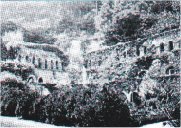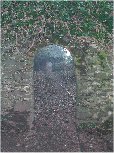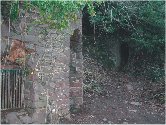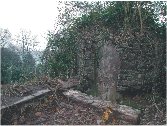
Ashley Combe, Porlock Weir, Somerset
Ashley Combe was built in 1799 and improved in 1835 when its owner, Lord William King (later created the First Earl of Lovelace), married Ada Byron (daughter of the poet) and set about building a romantic country home to please her, and probably using some of the money she brought into the marriage. The house was tucked into the woods overlooking the Bristol Channel and surrounded by most exotic terraced gardens in the Italian style.
Tunnels led tradesmen up from the road to the trade entrance of the house so that those within wouldn’t have to see their carts. A woodland walk and steps led down to the beach where a bath-house was built into the cliff to enable Ada to bathe in privacy.
The house, in the style of those to be found around the Italian Lakes, had an impressive clock tower. The gardens themselves consisted of walks, one above the other and backed by a row of alcoves, joined by spiral stairs. Beyond these were a series of gardens, walled at the back and sides and facing out of the woods down to the river below. These contained hot-houses. Decorative towers, turrets and archways were littered amongst the wooded walks.
By 1939 the house had been let out to Dr Barnardos for the duration of the war and in 1950 it became a Country Club. By now the house had fallen into a bad state of repair and when the Country Club was closed after acquiring a dubious reputation, its owner, the 4th Earl of Lytton, decided to pull it down.
Tunnels led tradesmen up from the road to the trade entrance of the house so that those within wouldn’t have to see their carts. A woodland walk and steps led down to the beach where a bath-house was built into the cliff to enable Ada to bathe in privacy.
The house, in the style of those to be found around the Italian Lakes, had an impressive clock tower. The gardens themselves consisted of walks, one above the other and backed by a row of alcoves, joined by spiral stairs. Beyond these were a series of gardens, walled at the back and sides and facing out of the woods down to the river below. These contained hot-houses. Decorative towers, turrets and archways were littered amongst the wooded walks.
By 1939 the house had been let out to Dr Barnardos for the duration of the war and in 1950 it became a Country Club. By now the house had fallen into a bad state of repair and when the Country Club was closed after acquiring a dubious reputation, its owner, the 4th Earl of Lytton, decided to pull it down.




Although the house has been demolished, the gardens count as a ruin in their own right, although private property and used as a pheasant run for the local shoot. The archways and spiral staircase are still to be seen as well as intriguing little dark passageways which lead away in the hills. Most of the tunnels have now been demolished, for safety, or bricked up but I remember, as a child, how eerie it was to walk along a curving tunnel where, in the middle, no daylight could be seen except through a little square hole in the roof. The photos show some of the features that remain and they can also be picked out in the black and white photograph
on the left – in particular the tower in the left of the photo, which is pictured in the
second photo from the right.
Copyright © 2002 Ruinhunter.co.uk